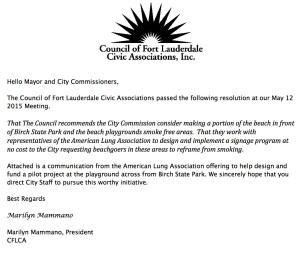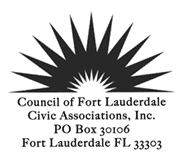Resolutions of Council
Consensus Report on Density
The Consensus Report on Density was adopted at the May General Membership Meeting. The Report was prepared by the Comprehensive Planning Committee Chaired by Steve Buckingham, President of Tarpen River Civic Association. It was forwarded to the Mayor and City Commissioners and the City Manager as input to the City Commission Density Workshops. We look forward to discussing the Report with the Commisiners at an upcoming workshop.
CFLCA Consensus Statement on Density
Council of Fort Lauderdale Civic Associations
Consensus Statement to the City Commission on Development/Density
The Council of Fort Lauderdale Civic Associations believes that the City of Fort Lauderdale should encourage human-scaled neighborhoods over urban sprawl, multiple transportation modes over automobile dependence and orderly, predictable development patterns that balance growth with neighborhood preservation.
We feel strongly that Fort Lauderdale should:
- Encourage transit-friendly office, commercial and multi-family residential development within high density, mixed-use activity centers (ex: Downtown RAC, S. Andrews Ave/SRAC) surrounded by lower density/single-family neighborhoods, parks and natural amenities.
- Discourage unsustainable, inappropriately-scaled development on the barrier island.
- Continue to explore new opportunities for growth in the Uptown district and along the major identified corridors. However, until planning for a predictable and acceptable level of density and design is agreed upon, new large-scale projects should be discouraged or subject to further review.
- Provide greater incentives for sustainable development that utilizes solar, wind, and other alternative energy sources to power the projects’ needs once built.
With 3 annual Neighbor Surveys pointing to traffic flow/congestion as the single biggest challenge facing the city, increased large-scale development and density should be encouraged only in sections of the city that either presently have the necessary transportation and self-supporting infrastructure (places of employment, shopping, food choices, etc.) in place to mitigate traffic flow issues or in sections of the city where it is planned and financed for the immediate future. For example, the Council would be generally supportive of density development along the phase 1 route of the Wave Modern Streetcar as it would be conducive to place more housing where residents have public transportation options. We also strongly support more transit options to airport, beach and the port to reduce car trips.
Further, we believe that growth and neighborhood strengthening can be accomplished by committing to the following:
- We advocate an acceleration of improving neighborhood streets deemed critical for the movement of people by all methods of transportation; specifically sidewalks, bike lanes, crosswalks, lighting, street striping, and details outlined in “Complete Streets” and “Connecting the Blocks”. We would not be supportive of large-scale residential construction moving forward in any neighborhood unless these aspects of planning are either in place or planned and financed in part or wholly by the developer.
- We support promoting distinctive, attractive neighborhoods and local business districts with a strong sense of place, including the rehabilitation, re-use, and protection of structures of importance; specifically, we support emphasizing and protecting existing community assets such as community centers, existing or planned parks, waterway access points and vistas, historic structures, etc.
- We support responsible, compatible growth in existing neighborhoods. For example, more needs to be done to preserve the general character of established neighborhoods that have developed over time. In-fill residential development (i.e., duplexes, cluster dwellings, etc.) has often become out of character with the pre-existing built environment and we request a review and modification of height and bulk allowances for new construction on existing lots in residential neighborhoods that are mostly composed of older stock, single family homes. Regenerate and implement the recommendations of the ULDR Modifications Plan outlined in the Neighborhood Development Criteria Revisions Project (NDCR).
- We want development decisions to be predictable and fair. While the Council supports flexibility from time to time for truly innovative development proposals that will enhance the community, we would prefer that Staff and Citizen Boards either stop or limit exceptions to our building codes and zoning regulations, especially within or nearby highly established and traditional neighborhoods.
- Continue to encourage and foster neighborhood participation as early as possible in development and density placement decision-making.
CFLCA Supports the EAB
The Fort Lauderdale Education Advisory Board sent a communication to the City Commission expressing concern that the Board Oversight Committee did not appear to have sufficient community representation. CFLCA sent a letter to the Broward School Superintendent supporting the EAB’s position.
Consensus Committee Report
Fort Lauderdale Council of Civic Associations
Consensus Committee Report
Adopted on January 8, 2013
POSITION STATEMENT: Fort Lauderdale is defined by its unique and diverse neighborhoods
GOAL: Enhance the quality of life for neighbors and preserve the diversity of neighborhoods.
PROCESS: Assemble concerns of member neighborhoods. In November an “issues congress” will be held by the Council to finalize the definition of all issues in this quality of life exercise. Once complete and adopted by the Council, the project will be presented to the City Commission, the City Manager, and the Visioning Committee for the purposes of prioritization, planning, budgeting, and staff resource allocation.
There are many issues managed by organizations other than the City of Fort Lauderdale that have a direct impact on the quality of life with our neighborhoods. It is assumed that the City of Fort Lauderdale would exercise every option to enhance things like education and the arts to enhance the life of its citizens. Other issues like traffic, airport and port management, the hospital system and business development incentives require proactive interaction by the City in order to maximize the results for neighbors.
NEIGHBORHOOD ENHANCEMENT
Summary – Neighborhood Enhancement
Redevelopment has entered some neighborhoods at a cost to the quality of life. Growth and the absence of action have resulted in neighborhood cut through traffic. The volume, speed and presence have impacted the ability of residents to safely walk and cycle. The system of sidewalks and bike paths is incomplete and inadequate.
Recommended Actions – Neighborhood Enhancement
- Maintain single-family neighborhood ambiance
- Implement NRDC
- Quantify “Neighborhood compatibility”
- Refine code for “mixed use” neighborhoods
- Petition the State of Florida to permit regulation of vacation rentals
- Update Codes and Ordinances
- Windpower
- Solar installation
- Urban farms/community gardens
- Roof and vertical gardening
- Honor all Master Plans filed with the City during review and approval processes
- Increase the notice to neighbors both in time and visibility for all parts of the development review process for both residential and commercial
- Balance neighborhood character with smart re-development
- Steer density to downtown core
- Utilize downtown master plan to direct development/developers
- Honor the past with preservation efforts
- Blend new development with historic neighborhoods
- Provide fiscal incentives to retain architecturally significant homes
- Protect and enforce historic overlays
- Requirements for new development should be forward sighted and include:
- Vacation of alleys for developers valued by three-dimensional square footage
- Long term plans for energy conservation
- Buried lines, streetscape improvements, density requirements
- Vacant Lots and Derelict buildings
- Incentivize owners to maintain. Alter punitive orientation
- Enforce code; Consider Eminent Domain possession for resale
- Establish aggressive position with banks and financial institutions negatively impacting neighborhoods and adding to City costs
- Manage cut through traffic
- Use roundabouts to slow traffic and conserve energy
- Install medians and “bump outs”
- Increase “walkability” and “cyclibility” within the City
- Shade sidewalks and increase canopy
- Install crosswalks, bike paths, and buffered bike lanes
- Widen sidewalks
- Incentivize property owners to install, widen walks
- Insure contiguous sidewalk access to public transportation
- Add bicycle issues to building codes (parking, access)
- Create a “Bicycle and pedestrian Advisory Board” for he City
- Integrate neighborhoods with the beach, other entertainment and services via walkways, bike paths and public transportation
- Assume waterways as component of feeder system
- Proactively use “complete streets” concepts to maximize benefits of mass transit expansions
- Assure adequate parking provisions for neighborhoods adjacent to business areas during re- development and new construction
- Use code as custodian of neighborhood quality of life
- Particularly the challenge in commercial/residential intersections and mixed-use areas.
- Disperse low income housing across all neighborhoods and seek private sector solutions
INFRASTRUCTURE
Summary – Infrastructure
Maintenance and repair of infrastructure is insufficient. Lack of routine replacement has caused catatrosphic failure, neighborhood impact on health and safety, and cessation of services. In addition, the decline in maintenance has negatively impacted businesses in the City which serve neighborhoods. The process by which repair and maintenance is scheduled does not factor elements, traffic, opportunity costs and other causal elements in the prioritization process. Public transportation is not currently a viable option for Fort Lauderdale neighbors.
Recommended Actions – Infrastructure
- Change the Canal dredging frequency and rotation
- Vegetation growth, neighborhood and erosion factors are not currently factored in scheduling
- Address neighborhood flooding issues
- Continue purchase of “flood plain” land
- Assess the valve project
- Clear street drains on a routine basis
- Accelerate the replacement of aging water and sewer lines
- Catastrophic failures have endangered neighborhoods, canal waters, businesses
- Reassess the rotation of street surfacing and culvert replacement
- Secure and explore current and future potable water sources
- Promote use of reclaimed water
- Public transportation within and to the Downtown core
- Remove the duplication of TMA/County bus routes/The Wave
PUBLIC PLACES
Summary – Public Places
The Council published a Parks position paper February 2009. It was re-issued in 2011. The report is attached. The cornerstone of the report was a “no net loss” policy. Public spaces set the tone for the neighborhood and are an indicator of the health of the City.
Recommended Actions – Public Places
- Increase both green space and passive parks in neighborhoods
- Use abandoned property and City owned property
- Involve the immediate neighbors and City residents as stakeholders in park planning
- Preserve current green space and native habitat
- Maintain affordable and convenient public access to the Beach and the River for City residents
- Establish a contiguous walk on both the north and south sides of the river
- Set “Urban Forest” goals
- Maintain and increase canopy
- Root pruning by City
- Shade sidewalks (use DT master plan goals throughout the City for landscaping)
- No removal of mature trees
- Explore the PUD ordinance for options to increase green space requirements
- Secure the safety of public places for use by families and residents of all ages
- Prioritize and budget for maintenance of medians and public properties
- Enforce “Dog Ordinance” to assure healthy environment for Park users
PUBLIC SAFETY and SOCIAL SERVICES
Summary – Public Safety and Social Services
Crimes by youths and the ‘underserved’ increase and impact the quality of life for all residents. Youth services and education are critical components to turn around the trend.
Recommended Actions – Pubic Safety and Social Services
- Continue the neighborhoods policing teams initiated in 2011
- Explore creative solutions for youth crime
- Share the burden of distribution in order to prevent “ghettoization” of neighborhoods
- Select public transportation corridors for social services
- Provide adequate services to the homeless and underserved
INTERNAL SUPPORT
Summary – Internal Support
Improvement of response time and effectiveness of response presents a cost saving opportunity.
Partnering for a result is a change neighbors would welcome. Proactive and progressive code/ordinance changes incorporating incentives would benefit both the residential and business community.
Recommended Actions – Internal Support
- Establish more City staff power to create solutions and address concerns
- Reward partnering across “silos”
- Coordinate abandoned property issues across departments
- Provide a bridge to FDOT and other County and State agencies
- provide resident input
- improve finished product
- Inform and involve stakeholders (neighbors)
- Residents are an invaluable resource before, during and after any initiative
All Aboard Florida EIS
May 28, 2013
Ms Catherine Dobbs
Transportation Industry Analyst,
Office of Railroad Policy and Development
Federal Railroad Administration
1200 New Jersey Avenue SE
Washington, DC 20590
Subject All Aboard Florida
Environmental Impact Statement
Dear Ms Dobbs,
The Council of Fort Lauderdale Civic Associations is a coalition of homeowner and civic associations in Fort Lauderdale. We have been following the progress of various transportation projects along the Florida East Coast Railroad. We understand that the All Aboard Florida Project will increase the number of trains transiting through Fort Lauderdale and facilitate even additional train traffic with the introduction of commuter rail service in the future and increased freight train traffic associated with improvements at Port Everglades.
The Council is devoted to maintaining and improving the quality of life for our residents. Mass transit improvements will increase mobility, reduce congestion, create jobs and protect the environment. These are all worthy goals that we endorse. However, every project has consequences and the Environmental Impact Statement must identity these consequences and possible mitigation actions.
Based on input from our members at various meetings there are a number of issues that must be addressed in the scoping of the Environmental Impact Statement (EIS) for the project.
1. As the increased train traffic passes through Fort Lauderdale and adjacent to residential neighborhoods the noise impacts must be addressed. We understand that “quiet zones” have been discussed to mitigate this impact but have no information regarding their effectiveness or cost. The EIS should consider the cost of implementing “quiet zones”, who will pay for them and maintain them?
2. As increased train traffic passes through Fort Lauderdale there will be and increase in the wait time at the grade crossings. What will the impact be on emergency service vehicles, police and fire services? Does the City have sufficient infrastructure located on both sides of the tracks to handle these issues or will an interruption of services cause harm to the public.
3. As increased train traffic passes through Fort Lauderdale, what provisions are being made to protect pedestrians and motorists from accidents at railroad crossing?
4. As increased train traffic passes through Fort Lauderdale, recreational boaters living in western neighborhoods will experience significant and potentially dangerous delays at the railroad bridge across the New River. What provisions are proposed to deal with this issue?
With all of these issues, the EIS should address the responsibility of the private operator to contribute to the cost of mitigation. Also what level of government, Federal, State, County or Local will be responsible for implementing and funding the mitigation? There should also be consideration of impacts associated with other projects that are likely to be facilitated by All Aboard Florida.
Consideration of these issues is imperative. We hope that the EIS will provide definitive answers to these questions.
Sincerely
Marilyn Mammano
Marilyn Mammano, AICP, President
Council Of Fort Lauderdale Civic Associations
June 13, 2012
Mr. Patrick McTigue, Chairman
Planning and Zoning Board
City of Fort Lauderdale
100 North Andrews Avenue
Fort Lauderdale 33301
Dear Mr. McTigue:
At June 12 General Membership Meeting of the Council of Fort Lauderdale Civic Associations, the members voted to send this correspondence to you regarding the proposed changes to the City-Wide Parking Regulations.
Regarding the draft proposal that the City presented at a May 22 Public Meeting, we don’t believe that the one-size fits all approach taken by the City is appropriate. Parking regulations should be more nuanced and specific to their location. While some neighborhoods would benefit from reduced parking requirements for some uses, others may be overwhelmed by inadequate requirements.
I will be at the June 20 Planning and Zoning Board meeting and will be happy to answer any of your questions.
Marilyn Mammano, AICP, President
Council of Fort Lauderdale Civic Associations
Cc: Mr. Greg Brewton, Director
Department of Sustainable Development
Ms Diana Alarcon, Director
Department of Transportation and Mobility
Resolution to Commission on Utility Cabinets
In accordance with a unanimous vote of the General Membership, the following resolution was transmitted to the Mayor, Commission and staff.
RESOLUTION
WHEREAS, the State of Florida has passed HOUSE BILL 529, “The Consumer Broadband Choice Act of 2007”, that authorizes the State of Florida to grant state-issued franchises to AT&T and any number of other telecommunication companies for the intended purpose of allowing these companies to provide Florida residents with competitively priced DSL and cable TV services; and
WHEREAS, the unregulated unsightly appearance and location of the telecommunication equipment used to provide these services has and will have a profound negative impact on the safety along our public rights-of-way, the appearance of neighborhoods, and property values throughout Fort Lauderdale.
NOW THEREFORE, be it resolved by the Council of Fort Lauderdale Civic Associations:
That the Council formally objects to the unsightly appearance and location of the telecommunication equipment that has already been constructed on both public and private property in the City of Fort Lauderdale; and
That the Council fully supports the City of Fort Lauderdale’s anticipated creation of an Ordinance to regulate the appearance and location, on both public and private property, of all telecommunication equipment, both existing and planned, authorized by House Bill 529, in order to minimize the negative impact this equipment will have on the safety along our public rights-of way, the appearance of our neighborhoods and property values; and
That the Council formally requests that the aforementioned Ordinance include a requirement that all telecommunication equipment authorized by House Bill 529, be placed on poles or underground whenever possible; and
That the Council formally requests that the aforementioned Ordinance include a requirement that all telecommunication companies in the process of planning the construction of this equipment be required to consult with appropriate neighborhood representatives and property owners prior to receiving a permit for construction of the planned equipment, in order to ensure a minimal impact on the proposed location.
Adopted this, the 11 day of September, 2007.
Eugenia D. Ellis , President On behalf of the Council of Fort Lauderdale Civic Associations
Resolution Las Olas Marina
Resolution Las Olas Marina – July 12, 2005
At the July 12, 2005 Council of Fort Lauderdale Civic Associations meeting, Mr. John Terrell, Marine Advisory Board Chair, presented the findings of that Board on the proposed change of use to allow commercial rental of dockage for the Las Olas Marina which would reduce the recreational use of the facility.
P. O. Box 1492 Fort Lauderdale, Florida 33302 July 12, 2005
City of Fort Lauderdale 100 North Andrews Avenue Fort Lauderdale, Florida 33301 Attention: Mayor Jim Naugle Vice Mayor Christine Teel Commissioner Dean Trantalis Commissioner Carlton Moore Commissioner Cindi Hutchinson City Manager George Gretsas City Attorney Harry Stewart City Clerk Jonda Joseph
Reference: Las Olas Marina – Change of Use
Ladies and Gentlemen:
At the July 12, 2005 Council of Fort Lauderdale Civic Associations meeting, Mr. John Terrell, Marine Advisory Board Chair, presented the findings of that Board on the proposed change of use to allow commercial rental of dockage for the Las Olas Marina which would reduce the recreational use of the facility.
Following a lengthy spirited discussion of the assembled membership, a motion to submit the following Resolution was made by David Marshall, Riverside Park, and seconded by Bunney Brenneman, Coral Ridge Isles. This motion was accepted by a unanimous vote.
By Resolution of the Council of Fort Lauderdale Civic Associations, It is hereby requested that the City of Fort Lauderdale make no change to the lease with the state of Florida regarding Las Olas Marina without significant public input through a hearing process.
The participating membership expressed considerable concern about making any changes to the existing lease that could allow for a commercial use at the marina on a temporary or permanent basis. Loss of those facilities to the recreational community would conflict with the consensus attained in establishing that facility initially.
Before any change is made to the existing lease or the facility use is given over to the Water Bus or any other commercial entity, we respectfully request a public hearing on the proposed change that could result in the loss of public recreational use.
Sincerely,
Eugenia Duncan Ellis President Council of Fort Lauderdale Civic Associations



